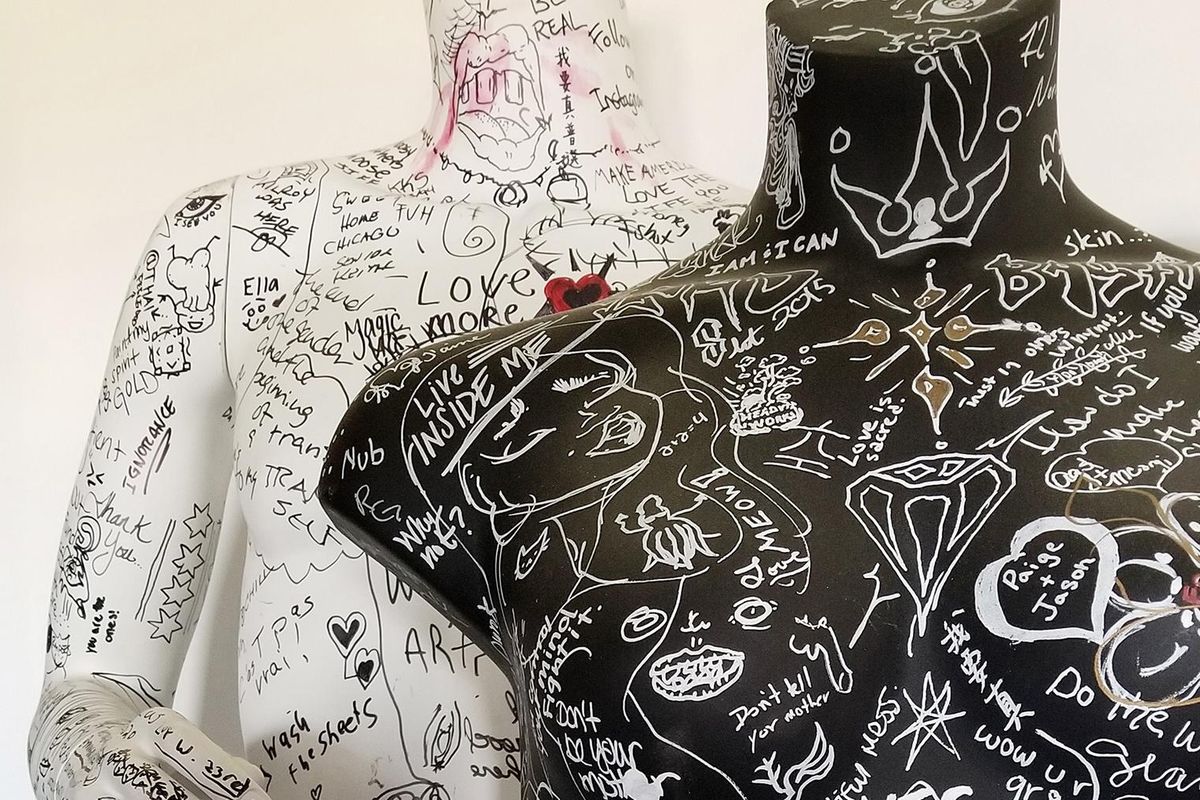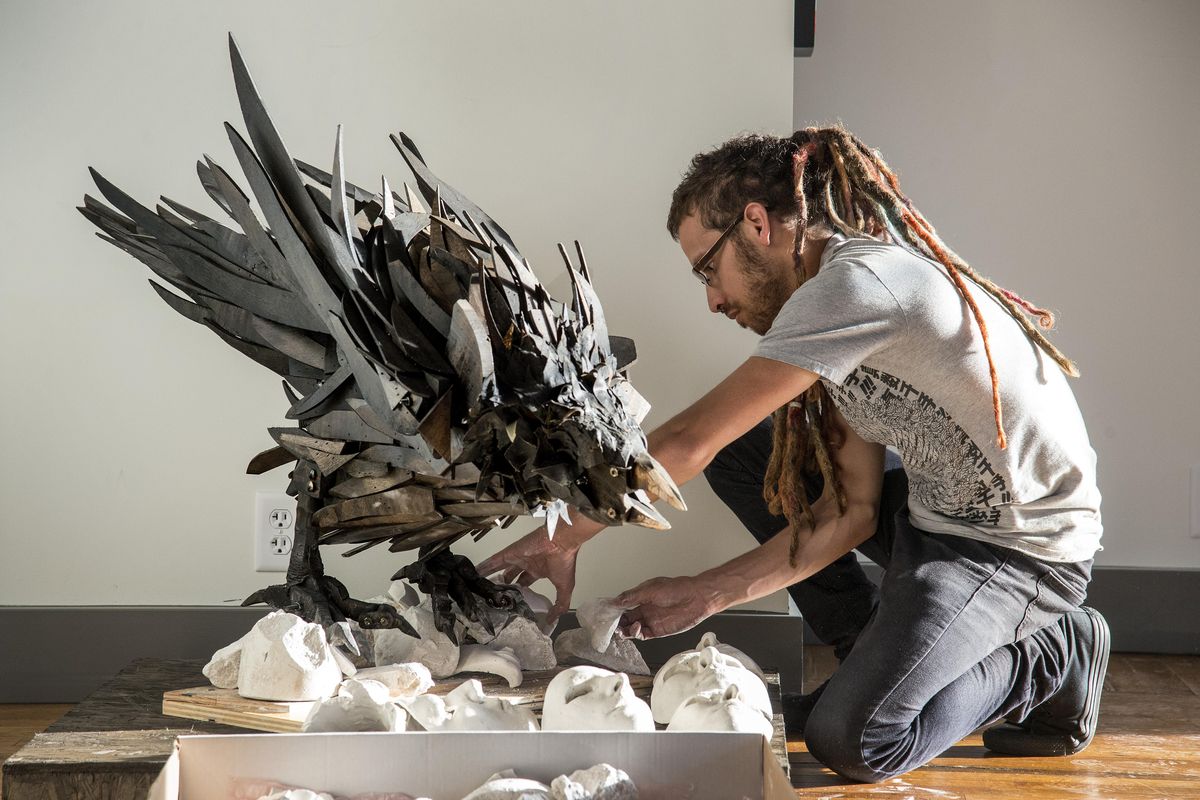Terrain celebrates 10-year anniversary with retrospective gallery show
Aritist Christian Mcgirk installs “Hostile,” made of wood, wood stain, plaster, latex, water based ink and sepia ink, in the Terrain gallery in 2015. (Colin Mulvany / The Spokesman-Review)Buy a print of this photo
In 2008, Terrain was a one-time, one-night only event meant to encourage young artists to stay in Spokane.
Thirty artists submitted work and about 1,200 people attended the first event.
Ten years later, Terrain has become an entity much bigger than its namesake.
The arts organization is now a 501(c)(3) that oversees three flagship events, Terrain, Uncharted and Bazaar, maintains a permanent exhibit space and oversees ongoing programming like Window Dressing and Creative Enterprise and retail space in the Pop Up Shop.
More than 300 artists submitted work for Terrain 10, and 8,500 people took in the event.
To celebrate how far they’ve come, Terrain is hosting “Ten Years of Terrain,” a gallery show that features work from Terrains past.
“Ten Years of Terrain” opens Friday and runs through March 24 at the Washington Cracker Building.
In advance of the gallery’s opening, Terrain co-founders Ginger Ewing and Luke Baumgarten talked about some of the most memorable pieces from all 10 years of Terrain, many of which are featured in “Ten Years of Terrain.”
2008: Scott Kolbo’s “Heavy Man Frown,” which featured “Looney Tunes”-esque stars projected over the image of a man.
“The way that Scott used to put those digital pieces together, because of technology in the past 10 years has changed dramatically, it’s an entirely different process …,” Ewing said. “We’re modifying that particular piece.”
Rajah Bose’s photographic series was another highlight from the inaugural Terrain.
2009: “Kaleidoscopic Youth,” a series of mixed media pieces from Megan Martens.
“I remember standing in front of them and they’re pretty powerful,” Ewing said.
2010: “Paper Underwear” by Austin Stiegemeier (in the place of “Paper Shoes,” which appeared at Terrain 3).
“The work he did in year three was the beginnings of the emergence of what I think has become his style, which is a really beautiful mix of realist painting or drawing mixed with elements of graffiti and street art,” Baumgarten said. “His subject matter is usually dark recesses of society.”
Ryan Desmond’s realistic large-scale paintings of pieces of meat, which stirred up controversy around Spokane when many vegetarians and vegans requested restaurants like Soulful Soups and Spirits take the paintings down, were also a highlight of Terrain 3.
2011: Juventino Aranda’s “Rollin’ in Peace (R.I.P.)”
The piece featured a Radio Flyer positioned in a way that made it look like it was using hydraulics. The wagon was controlled with a Nintendo 64 controller.
“That particular piece was in the window as you came in and I was like ‘Everybody’s going to remember this piece,’ ” Ewing said.
“A lot of the work that Juventino does is very, very serious, but he also has a sense of humor and it’s one of the things I really love about him as an artist,” Baumgarten said.
Mariah Boyle’s large-scale drawings were also a highlight from Terrain 4.
2012: “ScapeSkin” by the Divine Jewels (a video of the performance will be shown at “Ten Years of Terrain”)
During “ScapeSkin” the Divine Jewels, aka Jewels Dietrich, wrapped herself in gauze and invited Terrain attendees to write something that was troubling them – about their body, their mind or their world in general – on her body.
“This is the first performance piece where people waited in line for 45 minutes and the line wrapped all around the building so they could participate with her,” Ewing said.
After nearly eight hours, the Divine Jewels came to the center of the room and washed her body and those worries away.
2013: Tiffany Patterson’s “Tiny Triumphs, Little Victories” an iteration of a collaboration between Patterson and developer Mark Simon that bloomed from a Terrain-organized hackathon.
For Terrain 5, Patterson and Simon created a room with an Xbox Connect camera inside. As attendees danced in the room, the camera projected the movements of each dancer to make it look like their bones were dancing, the same way it looks when a cartoon character passes through an X-ray machine.
2014: “Choose Your Own Adventure” by Alan Chatham.
Another interactive piece, Chatham created a choose your own adventure experience for attendees who answered a ringing payphone.
Terrain 6 also featured work from ceramicist Lisa Soranaka. One piece included leaf- or coral-like ceramic pieces draped over antique pieces of furniture.
“One of the things we thought about was what instills a sense of wonder,” Baumgarten said. “What we’ve always tried to do is make it clear to people that art isn’t an ivory tower and it’s the sort of thing that can really inspire awe and wonder.”
2015: Rajah Bose’s “Black and White.”
Bose brought four mannequins – a black female and black male and a white female and white male – and allowed attendees to write thoughts about their bodies or human interaction in general on them.
While installing the mannequins for “Ten Years of Terrain,” operations director Jackie Caro discovered one of the mannequins said “Donald Trump 2016” along the side.
“Part of the work of being an artist is being in tune with what’s happening in the culture,” Baumgarten said. “It’s fascinating that a generative art piece was able to cast light on something that I don’t think any one of us thought was possible even after it happened.”
“Black and White” was also a comment on gender and race. The white male mannequin cost $5,000 and the black male mannequin cost $3,000, while the white female mannequin cost $2,500 and the black female mannequin cost $1,500.
Another highlight of Terrain 8 was Olive Pete, the youngest artist to ever show at Terrain. She was just 8 years old when she made her Terrain debut, and she sold every single piece at the show.
“They’re really delightful and playful and have a sense of wonder,” Ewing said. “If you didn’t know that a child did them, people would still be very much drawn to them, but the fact that an 8-year-old painted them makes them that much more powerful.”
2016: Lou Lou Pink.
For Terrain 9, Lou Lou Pink, the stage name of Jamie Nadherny, created a cape of sorts covered with family heirlooms. The piece acted as both a sculptural piece and performance piece, as throughout the night, Lou Lou Pink put the cape on and walked around the venue.
“My interpretation of it is where she comes from, where she’s rooted, but also that heaviness of carrying that around, both in a positive and negative sense …” Ewing said. “It was mesmerizing. People were riveted by the piece itself. They were riveted by her performance.”
2017: Reinaldo Alexander Gil Zambrano’s woodcut relief prints.
“It has a sense of magic realism…” Baumgarten said. “It feels like there’s this hint of the mystic and the spiritual but rooted in realism like it’s a part of everyday life that I find really, really compelling.”
“They’re some of the most beautiful relief prints that I’ve ever seen anywhere,” Ewing added.
Terrain, as an event and an organization, has changed significantly since its 2008 debut. Ewing and Baumgarten aren’t sure exactly what Terrain will look like in another 10 years, but they know it will continue to give artists and makers in Spokane a platform from which to share their talents with the community
“We’ve always seen ourselves as a community-based, -oriented, -focused organization so we’ll continue to respond to what we feel and hear that the community needs,” Ewing said. “Terrain in its current iteration might be exactly the same in 10 years from now or it might could be entirely different so we’re trying to create infrastructure and sustainability so we can continue to be responsive to what we see and what we hear our community needs.”
Ewing and Baumgarten also see Terrain’s growth as indicative of growth within the art community in Spokane as a whole.
“That’s a testament that we’ve hopefully had a really strong impact but the scene itself has gotten so much better,” Baumgarten said. “You can also say the community of people supporting art in this town is growing exponentially as well and we’re going to keep working to make that continue to grow because we still have a long way to go but that looks almost exponential sometimes too. It’s really incredible to take art in general as a microcosm and a lens through which to view the growth of Spokane as a cultural place and as a city that values ideas and values beauty and values community.”


